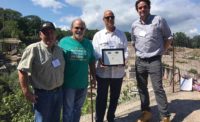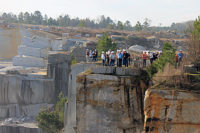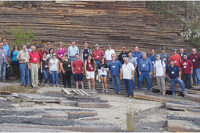Recently, Polycor offered a virtual tour of its Indiana limestone quarries during a webinar organized by the Natural Stone Institute (NSI). Moderated by Dacia Woodworth, NSI architect & design community liaison and special projects manager, the panel comprised Ralph Morgan, director of environment and sustainability for Polycor; Hayden Mayfield, Polycor project engineer; Tommy Zung of Studio Zung; and Robert “Rob” Barnes III, chairman and CEO of Dee Brown Inc.
Learning objectives for the webinar included:
- An overview of an operating limestone quarry and its history will highlight natural stone’s durability and sustainability and exemplify that utilizing natural stone in projects can benefit both user and nature.
- Discover the geological composition of the limestone harvested from an active quarry and the testing specifications available to ensure its properties are an accurate fit for certain installations and design.
- By providing installation examples and recommendations from a technical stone professional, the attendee will gain an understanding of the stone’s attributes and its performance in specific environments for optimal performance.
- An overview of the limestone utilized in creative projects by a design professional will highlight aesthetic success in past installations and provide insight for future creative opportunities for the customer.
Overview of Indiana Limestone
Morgan explained that the future looks promising for Indiana limestone quarries. “Within Polycor Group’s holdings, we easily have a thousand years of material -- probably closer to 1,500 years,” he said. “Supply is not a real problem. Trying to quarry it fast enough is really the issue. We have a very skilled group of workers.
“There are a multitude of limestone quarries around the country,” Morgan went on to say. “Indiana limestone is 97% calcium carbonate. From top to bottom [of the Indiana limestone belt] there is a difference, but [the limestone] is very consistent. If you are doing a job, you don’t want to mix between quarries because of those slight variations.”
According to Morgan, roughly 70% of the quarried material is discarded. “It’s not that it isn’t structurally sound, but it is not aesthetically what is wanted.”
It was explained that Indiana limestone is used for a diverse range of applications – from veneer to facades to residential projects. “There are iconic buildings made of Indiana limestone,” said Morgan. “That’s the beauty of Indiana limestone.”
Quarrying Operations
It was discussed that there is truth to the saying, “If you have seen a quarry, you have seen a quarry.” “Every quarry is different,” said Mayfield. “The geology can be slightly different based on color, based on grain.”
Mayfield went on to explain the process of finding the best stone to quarry. “The ‘meat’ of what we look for is that Salem level of limestone – typically four to five good benches of material in each quarry,” he said. “That’s our target area to quarry.
“It’s a chess game [when choosing the ledges],” Mayfield continued. “You can make one wrong move, and it can make your life miserable for the next six months, or years.”
The discussion also talked about the differences between surface quarries and underground quarries. “There are pros and cons to each,” said Mayfield. “Surface quarries can get more material more quickly. Underground mining is more targeted and more efficient from a cost perspective. We can get to the good material more quickly.”
Sustainability
During the last year and a half, Polycor invested in a dry-cutting method. “It takes 50% less workforce,” said Mayfield. “There is no waste on a block. That has been a huge win for us. We carried it to the underground operation as well. We’re getting better recovery.”
“Sustainability is the core of our company,” said Morgan. “That’s what we are trying to accomplish. Everything about us is about sustainability. We need to lower our dependence on carbon.”
Designing with Indiana Limestone
When it comes to designing with Indiana limestone, Zung recalls how he appreciates the beauty of thousand-year-old buildings. “The feeling of Indiana limestone is incredibly soothing,” he said. “It’s Zen-like or Church-like.”
Zung explained how his firm is drawn to the composition of the stone. “We like the way it moves. If it gets a little wet, it changes color.
“We like to blur the lines between the inside and the outside,” Zung went on to say. “You want your clients to feel elated, happy, inspired. For us, Indiana limestone does that.”
Cost Comparison
The session concluded with Barnes illustrating how he convinced a client to switch the specification from cast stone to Indiana limestone for one of his company’s projects, Freedom Place at Old Parkland N. Campus in Dallas, TX. “I have a strong belief that buildings are supposed to stand the test of time,” he said. “They should be natural products and not manufactured. It gives you that awe-inspiring [look].”
Barnes explained that he asked his client, “How many times do you want to replace the material?” “You don’t have to replace natural stone,” he said. “It was an easy conversation with the owner. I [also] have a personal relationship with them.”
According to Barnes, the first building on this campus was built in 1894. “It was the first community hospital in the Dallas area, and it was built with Indiana limestone. So that started the conversation.
“When I saw price points and started talking with Indiana, I saw that we could get closer,” Barnes went on to say. “The owner didn’t want the product to look manufactured.”
Barnes explained that the building is a massive structure. “When we took it from cast stone to natural stone, we could increase the size of the pieces. This project had almost 60,000 cubic feet of material. There was a lot of different technologies used here. Some were done on a CNC [machine], some on old lathes and there was also handwork.”
Those in attendance had the opportunity to earn CEU learning credits. The Natural Stone Institute is a rich source of information for those looking to learn about the benefits of natural stone.
Look for a Stone World podcast soon with Morgan, who will share Polycor’s journey to become carbon-free by 2025.








